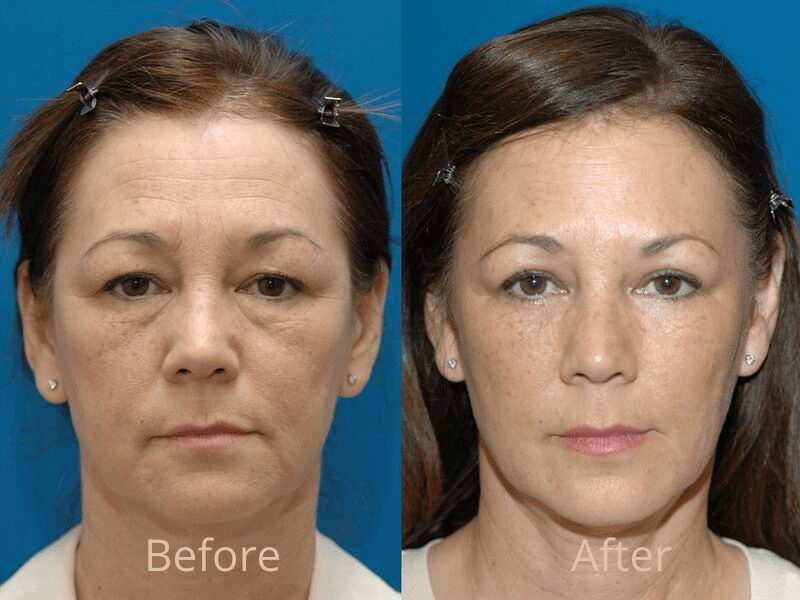
What is the Palpebral or Falling Eyelet Ptosis?
Ptosis ( falling down) is the displacement of one or more organs that tend to go down due to the force of gravity. The most common form of ptosis is that of the eyelids, which causes the eye to close, commonly known as “drooping eyelid.” However, in this article, we have discussed the Remedies for Droopy Eyelids!
The American Academy of Ophthalmology speaks of drooping eyelids meaning a condition in which one or both upper eyelids are lower than their normal level, whereby the eyelid line (space between the lower and upper eyelids) is reduced to varying degrees.
How to Understand if you have Mild Palpebral PTOSIS?
There are lots of surgeons and dermatologist who certainly has an eye trained in recognizing a small ptosis problem even if manifested in a mild form.
Noticing the problem, he proposes to the people to undergo a specific stimulation test of Müller’s muscle, which allows understanding whether or not there is the presence of ptosis; the test is simple and painless.
If it is positive, the Eyezcure dermatologists will recommend performing a corrective intervention of the ptosis transconjunctival (inside the eyelid and therefore without visible scars) in order to obtain an optimal result and in line with the patient’s expectations.
AESTHETIC SURGERY OF THE EYELEVES: PTOSIS OF THE PALPEBRAL WELL
Recent international studies have shown how many peoples suffering from mild forms of eyelid ptosis and not satisfied with the aesthetics of their gaze were subjected exclusively to upper blepharoplasty with the result of having a look that was always dull.
The importance of identifying the drooping eyelid defect using the Müller muscle stimulation test described above is fundamental in planning a combined superior blepharoplasty and simultaneous correction of ptosis. Only in this way will it be possible to give the people a look that is no longer tired but lively and energetic, always respecting the overall image of each face.
What are the Causes of Palpebral Ptosis?
ScienceDirect tell us the causes of eyelid ptosis are many and do not always depend on the age factor:
The most common are congenital (present from birth) or acquired (adult) type.
- The congenital ptosis eyelid in one or both eyelids is present from birth; this situation is due to insufficient development of the levator muscle.
- The ptosis acquired eyelid, or adult, can be distinguished in:
- Neurogenic forms following central or peripheral lesions of the III oculomotor cranial nerve or the cervical sympathetic.
- Muscular dystrophies and myasthenia gravis have myogenic forms.
- The mechanical forms are caused by eyelid tumors, scarring, orbital masses, dermatochalasis, and edema.
- These aponeurotic forms are caused by the dehiscence or disconnection of the levator aponeurosis and tarsal plateau. It is usually due to age or ophthalmological trauma like cataracts or retinal detachments.
- Traumatic ptosis is caused by laceration or disconnection of the aponeurosis or lesion of nerve fibers.
See resolution of traumatic ptosis below: the pupil of the right eye is larger as a result of the trauma.
Is Palpebral PTOSIS Intervention Possible?
Those who decide to resort to eyelid ptosis often do so not only to solve a problem that could compromise vision but also for an aesthetic question.
The eyes are given more and more attention, as well as what they can convey. This causes many women and many men to want to improve the appearance of the gaze region.
The person turns to the eye surgeons if:
- Ptosis causes a tired, sleepy, sad appearance that does not reflect the patient’s personality.
- Visual function is impaired, and the field of vision is limited.
- The lowering of the eyelids forces the patient to assume bad head postures, causing stiff neck and abnormal postures.
- To compensate for drooping eyelids, the patient frowns, resulting in an unsightly crease on his face and a headache.
The operation can be: The patient frowns associated with other techniques, such as blepharoplasty, nano lipofilling, and canthoplasty.
Each person will be directed and advised towards the most appropriate and avant-garde practices, according to the most up-to-date guidelines of the international surgical associations.
What is the Intervention of PALPEBRAL PTOSIS
Several surgical techniques allow ptosis correction based on the residual function of the levator palpebrae muscle.
- In a transconjunctival procedure, the levator palpebrae muscle aponeurosis and Müller’s muscle are strengthened. This technique allows obtaining excellent aesthetic results (both at the level of the eye-opening and the eyelid contour), especially for those who present mild eyelid ptosis.
- Reinsertion or shortening of the levator palpebral muscle aims to enhance the action of the levator muscle.
- Frontal muscle suspension can be used in cases where the levator palpebrae cannot be strengthened. In these cases, the eyelid can be elevated using the replacing action of the frontal. The suspension can occur with autologous material (i.e., taken from the patient) or heterologous (i.e., synthetic).
The operation has a variable duration depending on the complexity of the case and the search for the best intra-operative eyelid contour; it tends to last from 45 minutes to an hour and is performed under local anesthesia with mild sedation transconjunctival procedures make the surgery painless.
Eyelid ptosis correction surgery is undoubtedly one of the most advanced practices. Thus, in addition to having restored the normal position of the upper eyelids, which will make you regain possession of the entire visual field, your appearance will also benefit from it, and your eyes will return to being bright and lively.
“The surgical choice will take into account the individuality of each patient, respecting the naturalness and harmony of the face.”
What are the Results of an Interventionof Palpebral Ptosis?

“The intervention will customize dealing with, within train a natural appearance, to reflect the personality and the individuality of his image, to respect the needs expressed during the pre-operative interview.”
The external skin incisions made during the ptosis surgery are almost invisible because they are performed in the upper eyelid fold or even absent in the case of the transconjunctival technique. An adequate correction of ptosis restores the normal position of the upper eyelids with a benefit that is not only functional but also and above all aesthetic.
How to Remedies for Droopy Eyelids: Intervention that has not been Performed Elsewhere?
An unsuccessful ptosis surgery brings a sense of helplessness in those who have undergone it with a considerable load of expectations and the desire to solve a functional but also aesthetic problem.
When you find yourself having to deal with the results of unsuccessful ptosis surgery, you must try to understand what happened and find the right remedy. Those who suffer from eyelid ptosis with so-called drooping eyelids should use the best eye cream for droopy eyelids. However, there are cases where the problem is more visible and cases where it is less so.
What can lead to surgery failure?
Very often, an error of assessment is made. There is a tendency to consider blepharoplasty and ptosis corrections as specific interventions that cannot be performed jointly. This is why the results can be 100% unsatisfactory. Often, it is not the surgery performed badly, but the lack of overview does not give the desired result.
If the surgeon does not also evaluate the possibility of combining the ptosis correction with a blepharoplasty, the result may not be what was hoped for. A corrective and reconstructive intervention of the eyelid in the round is often needed.
The data prove this. In fact, in an ever-increasing percentage of persons who suffered from eyes, only the combination of the two interventions has led to obtaining a natural result, giving a look that serene and rested aspect that one wishes to have.
Finally, remember that laser-duplexer interventions cannot cure eyelid ptosis. This is, in fact, useful only in case of relaxation of the eyelid skin. Therefore, if you try to solve the droopy eyelid problem in this way, you will not get any results, and, in some cases, it could worsen the situation from an aesthetic point of view.
Looking is necessary to wait a few weeks before facing a new corrective intervention in most cases. Still, the advice is to contact the dermatologists immediately to evaluate the situation and establish the correct rehabilitation path.
Can droopy eyelids go away naturally?
If the upper eyelids are droopy, it can block or greatly reduce vision depending on how much it obstructs the pupil. Most of the time, the condition will resolve naturally or through medical intervention.
Can lack of sleep cause droopy eyelids?
In truth, droopy eyelids are caused by tired eyes due to lack of sleep. Sleep allows your levator muscles to rest and recharge so that your eyes can stay open the next day. When proper rest isn’t achieved, levator muscles become fatigued and weak.
What causes hooded eyelids?
Hooded eyelids: what causes them? Hooded eyelids are a result of a combination of many age-related changes in the skin, brow, muscles, and bones of the eyelids. In addition to a hooded appearance, droopy eyelids (eyelid ptosis) and a droopy eyebrow can exaggerate the hooded appearance. However, you can treat your droopy eyes by using an eye cream or applying the Remedies for Droopy Eyelids!






